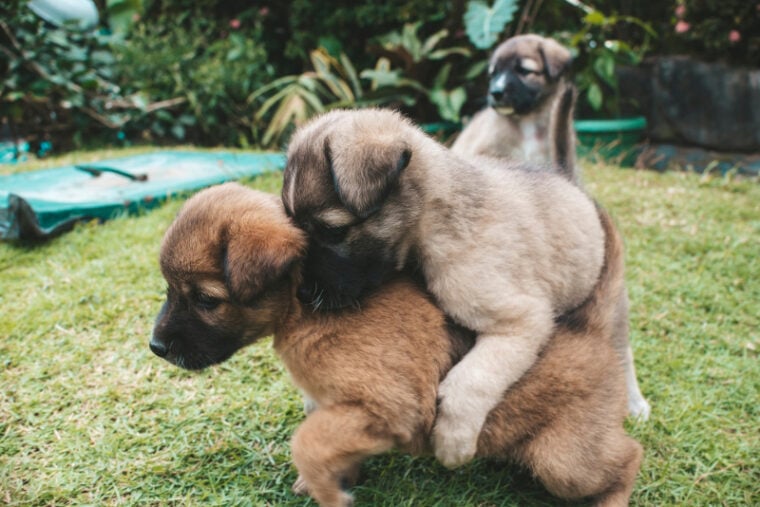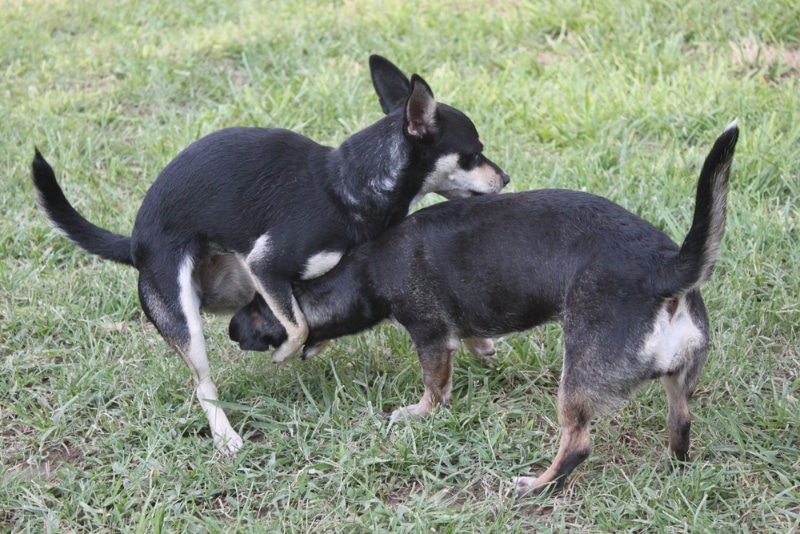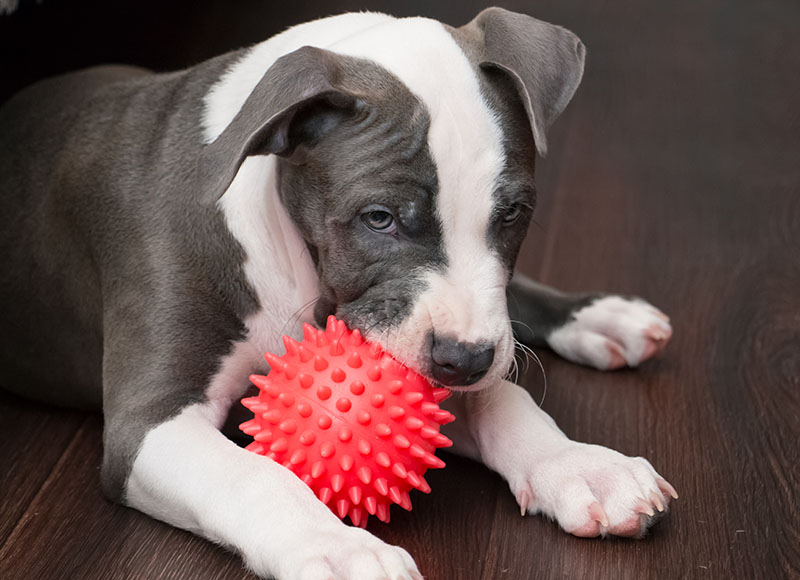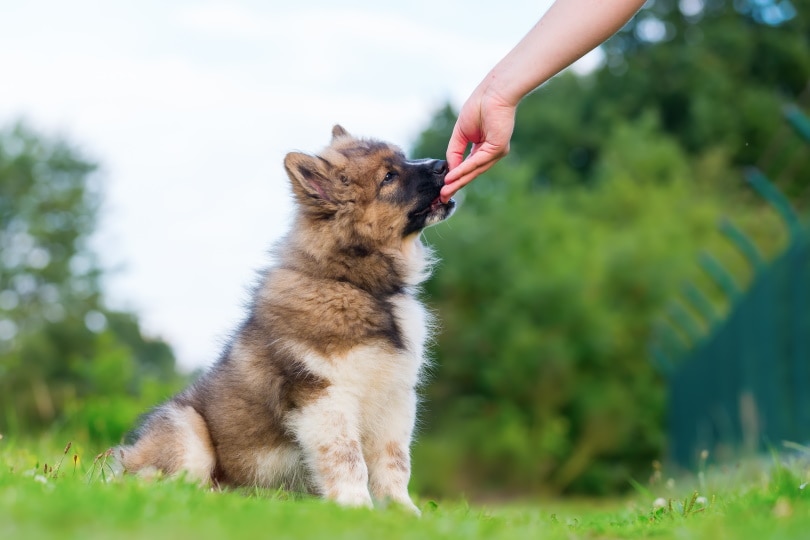
Click to Skip Ahead
It’s the primary embarrassment at the dog park and when your mother-in-law comes to visit. You want to look away, but unfortunately your dog shows no sign of stopping the behavior, so you’re awkwardly forced to intervene. Humping is often thought of as a sexual behavior, but the majority of the time, it’s actually anything but. Dogs of any age may hump for various reasons, including dominance or anxiety-related issues. While spaying or neutering may decrease certain types of humping, it’s very likely that you’ll continue dealing with the problem unless your dog is humping for purely reproductive purposes. Here are five common reasons that puppies hump (and what to do about it).
The 5 Common Reasons Puppies Hump
1. Adolescence

Dogs generally reach sexual maturity between 6 months and 1 year old. The exact age will depend on the individual dog, as well as their breed and sex. Large and giant breeds generally take a year or longer to sexually mature, while small dogs may reach sexual maturity around the 6-month mark. As a puppy’s reproductive hormones start to rise, so too may their humping behavior. Humping just comes natural as a puppy matures sexually and it may also turn into a pleasurable behavior.
However, if your puppy has been spayed or neutered before reaching sexual maturity, this is a less likely reason.
2. Dominance
If you study canine behaviors in the dog park, you’ll see that humping reoccurs as a common, though annoying, characteristic of puppy play. Dogs of all ages mount each other to display dominance. Whoever is on top is considered to be in charge in the canine kingdom.
3. Anxiety
Stressed dogs may turn to humping to relieve anxiety. This behavior is similar to self-destructive nervous habits in humans, such as biting fingernails. Reducing stressors and giving them chew toys to stimulate their mind may help to ease their discomfort and decrease humping.
4. Playtime

Puppies play for a living, and it’s easy for them to get carried away. Humping, especially during play, could just be they are getting a little overstimulated with their game and need a calming action to recenter, or they could simply be getting carried away during playtime. This is especially true if your puppy’s stuffed toys are getting the majority of the attention. If you’ve noticed that they direct their affections towards a specific pillow or toy, you could try to take it away from them until they learn humping isn’t okay—or at least while your family is visiting.
5. Medical Issues
Humping can also increase due to medical reasons like infections or irritations such as a urinary tract infection or prostate problem. If your puppy’s humping has a sudden onset or they are showing other signs, such as frequent urination, frequent licking of their genitals, or straining to urinate, see your vet.
How to Discourage Your Dog from Humping
Since humping is a deeply rooted behavior that could have more than one motive, it might take quite a lot of time and patience to train your dog out of it. Unfortunately, some dogs just seem a little more hump-happy than others. Here’s where you can start on the road to reclaiming your dignity at the dog park.
1. Recognize the Root Cause

Is your puppy humping their favorite toy after 15 minutes of rowdy playtime? They may be overstimulated. Has your puppy developed this curious new behavior around the time they’re 6 months old? They may be beginning adolescence. Once you learn what is building their habit, you’ll have an idea of how to break it.
2. Consider Spaying or Neutering
If your vet says your dog is old enough to safely undergo the procedure, you might try having your dog spayed or neutered to see if it curbs their mounting behaviors. Unfortunately, humping doesn’t always indicate an overzealous sex drive, so be prepared to follow up with training techniques if getting them “fixed” doesn’t fix the issue.
3. Redirect Their Attention

As much as you might want to yell at your dog (or sink through the floor depending on your personality), quickly and calmly switching their attention to something else is far more effective. In some cases, such as the favorite toy scenario, you might have to temporarily swap the victim of their affection for something less hump-worthy, such as a ball or a frisbee.
4. Try Time Out
If your dog insists on showing off their new moves to your guests, you might have to rush onto the scene to put your dog in a private time out in their crate. While experts warn that you don’t want to ever use the crate to punish your dog, the goal isn’t to make them feel bad about themselves. You’re only wanting them to refocus on something else. You can still use a treat, puzzle, or praise to let them know it’s not a punishment, just a brief calming period.
5. Reward Positive Behaviors with Attention and Treats

Another reason you don’t want to yell at your dog when they’re humping (or ever, really) is that you’re giving them attention. Some dogs thrive on any type of attention, whether it’s good, bad, or downright ugly. When disciplining your dog, it’s best to act quietly and quickly. Give a command word, such as “No,” and move on. When your dog changes their behavior to something good, however, that’s the time to shower them with all the praise and treats. If you sense that their behavior may be more anxiety than attention-driven, you might try to give them a treat puzzle or chew toy to calm them down and engage their mind in a positive way.
6. Create a Calm, Loving Environment
Since anxiety is also a common reason for humping, you’ll want to make sure your puppy grows up in a home that’s as stress-free as possible. Any dog can be your best friend, but some breeds in particular were created to be companion animals. Companion breeds, such as the Maltese, suffer terribly from being left at home alone for most of the hours of the day. If you must be absent for 8 hours or more, you might consider hiring a dog walker or asking a friend to come check on your dog during the middle of the time you’re away. When you do come home, remember to spend intentional time exercising and cuddling with your dog to make sure they feel loved.
Conclusion
Humping is a very natural behavior for dogs, regardless of their age or spay/neuter status. Thankfully, there are many things you can do to try to minimize this annoying trait. Maintaining a peaceful home and redirecting their behavior to something positive can go a long way to ensuring your dog’s health and happiness. Plus, training them not to hump will take away your shame when people come over to see your dog, er, you.
Featured Image Credit: MDV Edwards, Shutterstock







